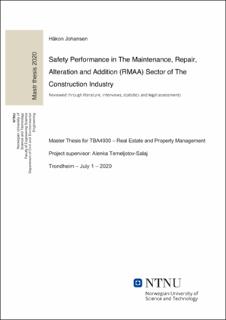| dc.contributor.advisor | Temeljotov-Salaj, Alenka | |
| dc.contributor.author | Johansen, Håkon | |
| dc.date.accessioned | 2021-09-20T16:17:59Z | |
| dc.date.available | 2021-09-20T16:17:59Z | |
| dc.date.issued | 2020 | |
| dc.identifier | no.ntnu:inspera:57484407:38083696 | |
| dc.identifier.uri | https://hdl.handle.net/11250/2779440 | |
| dc.description.abstract | Mellom 2014 og 2018 rapportert den Norske bygge- og anleggsnæringen den fjerde høyeste
ulykkesraten for alvorlige arbeidsulykker, og nest flest alvorlige arbeidsulykker totalt, av 14 industrier
klassifisert av Statistisk sentralbyrå (SSB). Arbeid i forbindelse med reparasjon, vedlikehold, drift og
renovasjon (RMAA) utgjør en stor del av den totale bygge- og anleggsindustrien, men blir ofte til en
viss grad oversett av investorer og beslutningstakere. Flere kilder hevder at RMAA-arbeidere er utsatt
for et høyere antall skader – både alvorlige og mindre alvorlige – enn det produksjonsarbeidere i byggeog
anleggsindustrien er. Denne oppgaven prøver å besvare hvorvidt dette faktisk er tilfellet i Norge. Et
annet mål med oppgaven har vært å se om det er spesifikke aspekter ved RMAA-sektoren med klare
forbedringspotensialer med tanke på sikkerhetsytelse. Funnene i denne oppgaven er uklare i så måte.
Intervjuer med RMAA-representanter avdekket at de generelt var godt fornøyd med dagens situasjon
med tanke på sikkerhet. Det bør bemerkes at tre dødsfall ble nevnt i intervjuene, men at alle disse skjedde
i forbindelse med produksjonsarbeid – og altså ikke i forbindelse med RMAA-arbeid. Heller ikke
statistiske vurderinger har kunnet bekrefte eller avkrefte at RMAA-arbeid er farligere enn
produksjonsarbeid; fordi skadestatistikken ikke er kategorisert på en måte som gjøre det mulig å vurdere
sikkerhetsytelsen til de to sektorene separat. Noen vurderinger av økonomisk statistikk er også foretatt
for å gi investorer og beslutningstakere insentiver til i høyere grad å prioritere RMAA-sektoren; og
sektoren er definitivt viktigere økonomisk sett, enn den er synlig. Tyskland og Storbritannia (GB) har
produsert separat statistikk for årlig økonomisk produksjon både for RMAA-arbeid og for
produksjonsarbeid. Dessverre er det ikke gjort tilsvarende separering av de to sektorene i den norske
statistikken for økonomisk produksjon i bygge- og anleggsbransjen. Underrapportering av
arbeidsulykker er et stort problem i mange land, men det eksisterer indikatorer på at situasjonen
muligens er verre i Norgen (hvor det har blitt estimert at 77,5% av arbeidsulykker ikke rapporteres) enn
i mange andre land, inkludert Danmark (45%) og Sverige (>70%). Selv medregnet denne høye
underrapporteringen presterer Norge bra i forhold til mange, inkludert Danmark; og ganske likt med
Sverige. Alle intervjuobjektene fremhevet et strengt lovverk som mye av årsaken til den relativt gode
situasjonen in Norge. På grunn av dette har også arbeidsmiljøloven blitt gjennomgått, og det er tydelig
at loven gir lite spillerom for farlig praksis på arbeidsplassen, uavhengig av om det er RMAA- eller
produksjonsarbeid det dreier seg om. | |
| dc.description.abstract | Between 2014 and 2018 the Norwegian construction industry recorded the fourth highest serious
accident rate, and the second highest number of serious accidents among 14 industries classified by
Statistisk sentralbyrå (SSB). The repair, maintenance, alteration and addition (RMAA) sector
constitutes a large part of the construction industry, but it tends to be somewhat overlooked by investors
and decision makers. Several sources claim that RMAA workers are susceptible to more accidents –
both severe and less severe ones – than production workers within the construction industry. This thesis
tries to answer whether this is the case in Norway. Another goal of the research has been to find out
whether there are particular aspects of RMAA work that has a clear potential for improved safety
performance. The findings of this thesis are inconclusive as regard to these goals. Interviews with
RMAA representatives revealed that they generally seemed happy with the current state of safety in
their work. It should be noted that three fatal accidents were mentioned during the interview, but that all
had occurred during production work – not during RMAA work. Neither were statistical assessments
able to confirm or discard whether RMAA work is more dangerous than production work; as Norwegian
accident statistics are not categorized in a way that makes it possible to separately assess safety
performance in the two sectors. Some economic assessments have also been performed in this thesis to
create incentives for decision makers and investors to consider the RMAA sector more thoroughly; and
the sector is indeed more important economically speaking, than it is visible. Germany and Great Britain
(GB) have produced separate statistics of annual monetary output ascribed to RMAA work and the
output ascribed to production work. Unfortunately, this distinction is not used for the economic statistics
of the Norwegian construction sector. Under-reporting of occupational accidents is an extensive problem
in many countries, but indications exist that the problem may be worse in Norway (where estimates
have been made that 77,5% of all occupational accidents go unreported) than in many other nations,
including Denmark (45%) and Sweden (>70%). However, even when accounting for the high relative
number of unreported accidents, the Norwegian construction industry’s safety performance compares
favourably to many countries, including Denmark; and similar to Sweden. All interviewees highlighted
strict laws and regulations as one of the main reasons for this success. Consequently, arbeidsmiljøloven
has been reviewed, and has indeed been found to give little leeway for unsafe business practices,
regardless of it is RMAA- or production work being performed. | |
| dc.language | | |
| dc.publisher | NTNU | |
| dc.title | Safety Performance in The Maintenance, Repair, Alteration and Addition (RMAA) Sector of The Construction Industry | |
| dc.type | Master thesis | |
